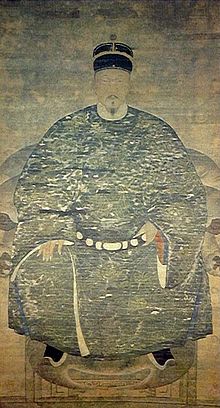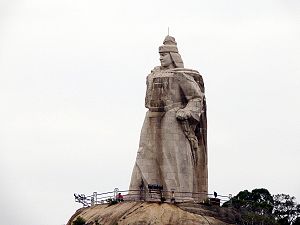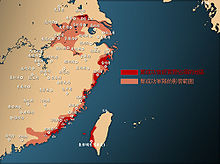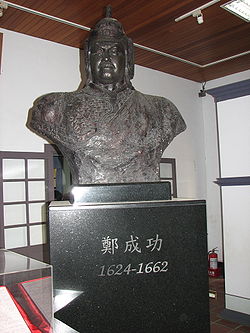- Koxinga
-
Zheng Chenggong
鄭成功
Born August 1624
Hirado, JapanDied June 23, 1662 (aged 37)
Tainan, TaiwanOther names Fukumatsu,[1] Teiseiko,[2] Zheng Sen (鄭森), Koxinga, Coxinga, Cocksinja[1] Occupation Military leader Title Guoxingye (國姓爺), Prince of Yanping (延平)[3] Successor Zheng Jing (鄭經) Spouse Dong Cuiying[4] Children Zheng Jing, Zheng Xi Parents Zheng Zhilong (Father), Tagawa (Mother) Relatives Tagawa Shichizaemon (Half-Brother), Zheng Cai (鄭彩) (Cousin),[5] Zheng Hongkui (鄭鴻逵) (Uncle),[6] Zheng Keshuang (鄭克塽) (Grandson), Zheng Kezang (鄭克臧) (Grandson)[7] Koxinga (simplified Chinese: 国姓爷; traditional Chinese: 國姓爺; pinyin: Guóxìngyé; Wade–Giles: Kuo-hsing-yeh; Pe̍h-ōe-jī: Kok-sèng-iâ/Kok-sìⁿ-iâ; literally "Lord with the Imperial Surname") is the customary Western spelling[8] of the popular appellation of Zheng Chenggong (simplified Chinese: 郑成功; traditional Chinese: 鄭成功; pinyin: Zhèng Chénggōng; Wade–Giles: Cheng Ch'eng-kung; Pe̍h-oē-jī: Tēⁿ Sêng-kong; Pha̍k-fa-sṳ: Tshàng Sṳ̀n-Kûng; Foochow Romanized: Dâng Sìng-gŭng), a military leader who was born in 1624 in Hirado, Japan to Zheng Zhilong, a Chinese merchant/pirate, and his Japanese wife and died in 1662 on the island of Formosa (Taiwan).
A Ming loyalist and the arch commander of the Ming troops on the maritime front for the later monarchs of the withering dynasty, Koxinga devoted the last 16 years of his life to resisting the conquest of China by the Manchus of Qing Dynasty. Upon defeating the forces of the Dutch East India Company (VOC) on Formosa in his last campaign in 1661–1662, Koxinga took over the island in order to support his grand campaign against the Manchu-ruled Qing Dynasty. After Koxinga's death, however, his son and successor, Zheng Jing (鄭經), gradually became the ruler of an independent Kingdom of Tungning, the first Chinese state to rule the island.
Early years
In 1624, Koxinga, whose name at birth was Zheng Sen, was born in Hirado, Nagasaki Prefecture, Japan to Zheng Zhilong, a Chinese merchant and pirate, and a Japanese woman whose surname was Tagawa, and whose given name has been lost to posterity.[9] He was raised there until the age of seven and then moved to Nan'an county in Quanzhou in Fujian province of China.
In 1638, Koxinga became a Xiucai (a successful candidate) in the imperial examination and became one of the twelve Linshansheng (廩膳生) of Nan'an. In 1641, Koxinga married the niece of Dong Yangxian, an official who was a Jinshi from Hui'an. In 1644, Koxinga studied at the Imperial Nanking University, where he met and became a student of the scholar Qian Qianyi.[10]
In 1644, Beijing fell to rebels led by Li Zicheng and the Chongzhen Emperor hanged himself on a tree at modern-day Jingshan Park in Beijing. Manchurian armies aided by Wu Sangui's forces defeated the rebels and took the city. The Ming remnant forces retreated to Nanjing where the Prince Fu ascended to the throne as the Hongguang Emperor. The next year, the Manchurian armies led by Dodo advanced south and conquered Yangzhou and Nanjing while the Ming leader defending Yangzhou, Shi Kefa, was killed. The Hongguang Emperor was captured and executed.
Longwu Emperor's reign
In 1645, Prince Tang was installed on the throne as the Longwu Emperor with support from Zheng Zhilong and his family.[11] The Longwu Emperor established his court in Fuzhou, which was controlled by the Zhengs. In the later part of the year, another Ming Prince Lu proclaimed himself as Regent (監國) in Shaoxing and established his own court there. Although Prince Lu and Longwu's regimes stemmed from the same dynasty, both of them pursued different goals.
It was due to the natural defences of Fujian and the military resources of the Zheng family, that the emperor was able to remain safe for some time.[12] The Longwu Emperor granted Zheng Zhilong's son, Zheng Sen, a new personal name, "Chenggong" (success), and the title of Guoxingye ("Lord of the Imperial Surname"; Koxinga).[12]
In 1646, Koxinga first led the Ming armies to resist the Manchurian invaders and won the favour of the Longwu Emperor. The Longwu Emperor's reign in Fuzhou was brief, as Zheng Zhilong refused to support his plans for a counter-offensive against the rapidly-expanding forces of the newly-established Qing Dynasty by the Manchus. Zheng Zhilong ordered the defending general of Xianxia Pass (仙霞關), Shi Fu (a.k.a. Shi Tianfu, a relative of Shi Lang), to retreat to Fuzhou even when Qing armies approached Fujian. As such, the Qing army faced little resistance when it conquered the north of the pass. In September 1646, Qing armies broke through inadequately defended mountain passes and entered Fujian. Zheng Zhilong retreated to his coastal fortress and the Longwu Emperor faced the Qing armies alone. Longwu's forces were destroyed and he was captured and died shortly afterwards.[13]
Zheng Zhilong's surrender and the death of Tagawa
The Qing forces sent envoys to meet Zheng Zhilong secretly and they offered to appoint him as the governor of both Fujian and Guangdong provinces if he would surrender to Qing. Zheng Zhilong agreed and ignored the objections of his family, surrendering himself to the Qing forces in Fuzhou on 21 November 1646.[14] Koxinga and his uncles were left as the successors to the leadership of Zheng Zhilong's military forces. Koxinga operated outside Xiamen and recruited many to join his cause in a few months. He used the superiority of his naval forces to launch amphibious raids on Manchu-occupied territory in Fujian and he managed to take Tong'an in Quanzhou prefecture in early 1647. However, Koxinga's forces lacked the ability to defend the newly-occupied territory.[15]
Following the fall of Tong'an to Zheng, the Manchus launched a counterattack in the spring of 1647, during which they stormed the Zheng family's hometown of Anping. Koxinga's mother, Lady Tagawa, had come from Japan in 1645 to join her family in Fujian (Koxinga's younger brother, Tagawa Shichizaemon, remained in Japan).[16] She did not follow her husband to surrender to the Qing Dynasty. She was caught by Manchu forces in Anping and committed suicide after refusal to submit to the enemy, according to traditional accounts.[17]
Resisting the Qing Dynasty
By 1650, Koxinga was strong enough to establish himself as the head of the Zheng family.[17] He pledged allegiance to the only remaining claimant to the throne of the Ming Dynasty, the Yongli Emperor. The Yongli Emperor was fleeing from the Manchus in south-western China with a motley court and hastily assembled army at the time. Despite one fruitless attempt, Koxinga was unable to do anything to aid the last Ming emperor.[17] Instead, he decided to concentrate on securing his own position on the southeast coast.
Koxinga enjoyed a series of military successes in 1651 and 1652 that increased the Qing government's anxiety over the threat he posed.[18] The fight carried out massacre in Zhangzhou.[19] Zheng Zhilong wrote a letter to his son from Beijing, presumably at the request of the Shunzhi Emperor and the Qing government, urging his son to negotiate with the Manchurians. The long series of negotiations between Koxinga and the Qing Dynasty lasted until November 1654. The Qing government appointed Prince Jidu (son of Jirgalang) to lead an attack on Koxinga's territory after the failed negotiations.[20]
On 9 May 1656, Jidu's armies attacked Jinmen, an island near Xiamen that Koxinga had been using to train his troops. Partly as a result of a major storm, the Manchus were defeated and they lost most of their fleet in the battle.[21] Koxinga had sent one of his naval commanders to capture Zhoushan island prior to Jidu's attack,[22] and now that the Manchus were temporarily without an effective naval force in the Fujian area, Koxinga was free to send a huge army to Zhoushan, which he intended to use as a base to capture Nanjing.
Koxinga on Taiwan
In 1661, Koxinga led his troops on a landing at Lu'ermen to attack the Dutch colonists in Taiwan. On 1 February 1662, the Dutch Governor of Taiwan, Frederik Coyett, surrendered Fort Zeelandia to Koxinga. During the siege, Koxinga's life was saved by a certain Hans Jurgen Radis of Stockaert, a Dutch defector who strongly advised him against visiting the overrun ramparts, which he knew would be blown up by the retreating Dutch forces.[23] In the peace treaty, Koxinga was styled "Lord Teibingh Tsiante Teysiancon Koxin" [4]. This effectively ended 38 years of Dutch rule on Taiwan. Koxinga then devoted himself to transforming Taiwan into a military base for loyalists who wanted to restore the Ming Dynasty.
Koxinga on the Philippines
In 1662, Koxinga's forces raided several towns on the Philippines and demanded tribute from the Spanish colonial government, threatening to attack Manila if his demands were not met. The Spanish refused to pay the tribute and reinforced the garrisons around Manila, but the attack never took place.[24]
Koxinga's threat to invade the Philippines and expel the Spanish resulted in the Spanish failure to conquer the Islamic Moro people in Mindanao. The threat of Chinese invasion forced the Spanish to stop their conquest of the Moros and withdraw their garrisons to Manila. Koxinga's death resulted in the invasion being cancelled.[25]
Death
Koxinga died of malaria at the age of 37. There were speculations that he died in a sudden fit of madness when his officers refused to carry out his orders to execute his son Zheng Jing. Zheng Jing had an affair with his wet nurse and conceived a child with her.[26] Zheng Jing succeeded his father as the King of Tungning.
Family Relationships
Koxinga’s short but eventful career was characterised by family tension and conflicting loyalties. The title of 國姓爺 guoxingye (‘Lord of the Imperial Surname’) was one that Koxinga himself used during his lifetime to emphasise his status as an adopted son of the deposed imperial house, and hence it was also a declaration of ongoing support to the Ming dynasty.[27] Despite his deliberate self-identification as the noble, loyal vassal of a vanquished master, however, Koxinga’s actual relationship with his adoptive father, the Longwu Emperor, lasted only twelve months or so, beginning from September 1645 and ending in the death of the Longwu Emperor in the following year.[28] Although many secondary sources claim that the two men shared a ‘close bond of affection’, there is an absence of any reliable contemporary evidence regarding Koxinga’s relationship with the Longwu Emperor.[29]
In contrast, Koxinga’s father, Zheng Zhilong, left his Japanese wife not long after the birth of his son;[30] Koxinga would be a boy of seven when he finally joined his father on the Chinese coast.[31] It seems that Zheng Zhilong recognised his son’s talent and encouraged him in his studies and the pursuit of a career as a scholar-official, which would legitimise the power that the Zheng family had acquired using sometimes questionable means.[32] Zheng Zhilong’s defection to the Qing must have seemed opportunistic and in stark contrast to Koxinga’s continued loyalty to the Ming. But it is difficult to deny that in refusing to submit to the Qing, Koxinga was risking the life of his father, and that the subsequent death of Zheng Zhilong could only be justified by claiming loyalty to the Ming.[33] It has even been suggested that Koxinga’s fury at the incestuous relationship between his son, Zheng Jing, and a younger son’s wet nurse was due to the fact that strict Confucian morality had played such a crucial role in justifying his lack of filial behaviour.[34]
The one possible exception to this may have been his relationship with his mother, which has generally been described as being extremely affectionate, particularly in Chinese and Japanese sources.[35] Their time together, however, was apparently very short - despite frequent entreaties from Zheng Zhilong for her to join him in China,[36] Koxinga’s mother would only be reunited with her son sometime in 1645, and a year later she would be killed when the Qing took Xiamen.[37]
Popular culture and other influences
Koxinga is worshipped as a god in coastal China especially Fujian and Taiwan and by overseas Chinese in Southeast Asia. There is a temple dedicated to Koxinga and his mother in Tainan City, Taiwan. The National Cheng Kung University in Tainan, one of the most prestigious universities in Taiwan, is named after him.
The play The Battles of Coxinga (Kokusen'ya Kassen, 国姓爺合戦; formerly 國姓爺合戰) was written by Chikamatsu Monzaemon in Japan in the 18th century, first performed in Kyoto. A 2001 film titled The Sino-Dutch War 1661 (鄭成功 1661) starred Vincent Zhao as Koxinga.[38] The film was renamed Kokusenya Kassen (国姓爺合戦) after the aforementioned play and released in Japan in 2002.
In politics, Koxinga is an interesting figure because several opposing political forces have invoked him as a hero. For this reason, historical narratives regarding Koxinga frequently differ in explaining his motives and affiliation.[citation needed]
Koxinga is considered a national hero in Mainland China because he drove the Dutch away from Taiwan and established ethnically Chinese rule over the island.[citation needed]
Koxinga is considered a pirate in the Philippines because of his banditry and raids on Philippine soil.
During the Japanese control of Taiwan, Koxinga was honored as a bridge between Taiwan and Japan for his maternal linkage to Japan.[citation needed]
The Chinese Nationalist Party regarded Koxinga as a patriot who retreated to Taiwan and used it as a base to launch counterattacks against the Qing Dynasty of mainland China. As such, the Nationalists have frequently compared Koxinga to their leader Chiang Kai-shek.[citation needed]
Supporters of Taiwan independence have held mixed feelings toward Koxinga. Recent Taiwanese independence supporters have presented him in a positive light, portraying him as a native Taiwanese hero seeking to keep Taiwan independent from a mainland Chinese government.[citation needed]
Koxinga is one of the 32 historical figures who appear as special characters in the video game Romance of the Three Kingdoms XI by Koei. He is addressed as "Zheng Chenggong" in the game.
In modern times, Koxinga is regarded as a hero in the People's Republic of China, Taiwan, and Japan for various reasons.
Memorial institutions
- National Cheng Kung University (Koxinga University)
- Cheng Kung Senior High School
- Cheng Kung class frigate
- Chenggong, Taitung
See also
- Koxinga Ancestral Shrine
- Kingdom of Tungning
- History of Taiwan
- Anti-Qing sentiment
- Great Clearance (1661–1669)
References and notes
- ^ a b Keene, The Battles of Coxinga: Chikamatsu's Puppet Play, Its Background and Importance, 45.
- ^ Paske-Smith, Western Barbarians in Japan and Formosa in Tokugawa Days, 1603 - 1868, p. 83.
- ^ Carioti, Patrizia. “The Zhengs' Maritime Power in the International Context of the 17th Century Far East Seas: The Rise of a 'Centralised Piratical Organisation' and Its Gradual Development into an Informal 'State'”. Ming Qing Yanjiu (1996): p. 52.
- ^ John E. Wills and Donald Keene both agree that Zheng's wife's surname was "Dong" (董), John E. Wills, Jr., Pepper, Guns and Parleys: The Dutch East India Company and China 1622–1681 (Cambridge: Harvard University Press, 1974), 28, and Donald Keene, The Battles of Coxinga: Chikamatsu's Puppet Play, Its Background and Importance, (London: Taylor's Foreign Press, 1950), 46. Jonathan Clements, however, claims her name was "Deng Cuiying", Jonathan Clements, Coxinga and the Fall of the Ming Dynasty (Phoenix Mill: Sutton Publishing Limited, 2004), 92. Chang et al., The English Factory in Taiwan, 1670–1685, Taipei: National Taiwan University, 1995. p. 740 introduces her as "Tung Ts'ui-ying", which would be "Dong Cuiying" in Hanyu Pinyin.
- ^ Struve, Southern Ming, p. 88.
- ^ Struve, Southern Ming, p. 77
- ^ Hung Chien-chao. “Taiwan Under the Cheng Family, 1662–1683: Sinicization After Dutch Rule.” Ph.D. dissertation, Georgetown University. p. 265
- ^ Koxinga's Shrine
- ^ Ralph Croizier, Koxinga and Chinese Nationalism: History, Myth, and the Hero (Cambridge: Harvard University Press, 1977), 11, and Donald Keene, The Battles of Coxinga: Chikamatsu's Puppet Play, Its Background and Importance, (London: Taylor's Foreign Press, 1950), 45. Tonio Andrade writes her name as "Tagawa Matsu" (田川松), but he provides no source for this. Tonio Andrade, How Taiwan Became Chinese: Dutch, Spanish, and Han Colonization in the Seventeenth Century (New York: Columbia University Press, 2007), Chapter 10, paragraph 7. [1]
- ^ Croizier, Koxinga and Chinese Nationalism: History, Myth, and the Hero, p. 12, and Carioti, "The Zhengs' Maritime Power in the International Context of the 17th Century Far East Seas: The Rise of a 'Centralised Piratical Organisation' and Its Gradual Development into an Informal 'State'", p. 41, n. 29.
- ^ Frederick Mote & Denis Twitchett, editors, The Cambridge History of China, Volume 7, The Ming Dynasty, 1368–1644, Part 1 (Cambridge: Cambridge University Press, 1988), 658–660.
- ^ a b Lynn A. Struve, The Southern Ming 1644–1662 (New Haven: Yale University Press, 1984), 87-88.
- ^ Frederick Mote & Denis Twitchett, editors, The Cambridge History of China, Volume 7, The Ming Dynasty, 1368–1644, Part 1 (Cambridge: Cambridge University Press, 1988), 675-676.
- ^ Lynn A. Struve, The Southern Ming 1644–1662 (New Haven: Yale University Press, 1984), 98.
- ^ Tonio Andrade, How Taiwan Became Chinese: Dutch, Spanish, and Han Colonization in the Seventeenth Century (New York: Columbia University Press, 2007), Chapter 10, paragraph 12. [2]
- ^ Donald Keene, The Battles of Coxinga: Chikamatsu's Puppet Play, Its Background and Importance, (London: Taylor's Foreign Press, 1950), 46.
- ^ a b c Lynn A. Struve, The Southern Ming 1644–1662 (New Haven: Yale University Press, 1984), 116.
- ^ Lynn A. Struve, The Southern Ming 1644–1662 (New Haven: Yale University Press, 1984), 159.
- ^ 郑成功的十大罪过,漳州大屠杀73万人
- ^ Lynn A. Struve, The Southern Ming 1644–1662 (New Haven: Yale University Press, 1984), 160–166.
- ^ Lynn A. Struve, The Southern Ming 1644–1662 (New Haven: Yale University Press, 1984), 181.
- ^ Lynn A. Struve, The Southern Ming 1644–1662 (New Haven: Yale University Press, 1984), 182.
- ^ Rev. WM. Campbell: "Formosa under the Dutch. Described from contemporary Records with Explanatory Notes and a Bibliography of the Island", originally published by Kegan Paul, Trench, Trubner & Co. Ltd. London 1903, republished by SMC Publishing Inc. 1992, ISBN 957-638-083-9, p. 452
- ^ Borao, José Eugenio (2010). The Spanish experience in Taiwan, 1626-1642: the Baroque ending of a Renaissance endeavor. Hong Kong University Press. pp. 199. ISBN 9622090834.
- ^ Daniel George Edward Hall (1981). [http://books.google.com/books?ei=22-HTtjPFKHj0QH2hqEQ&ct=result&id=FrFGAAAAMAAJ&dq=koxinga+moros+southeast+asia&q=koxinga [Original from the University of Michigan] A history of South-East Asia] (4, illustrated ed.). Macmillan. p. 278. ISBN 0333241630. http://books.google.com/books?ei=22-HTtjPFKHj0QH2hqEQ&ct=result&id=FrFGAAAAMAAJ&dq=koxinga+moros+southeast+asia&q=koxinga [Original from the University of Michigan]. Retrieved 29 September 2011. "Moro depredations and enabled the Spaniards to take the offensive against the Moro baes at Jolo and on Lake Lanao in northern Mindanao. Neither side, however, could win an outright victory, and when the Chinese leader Koxinga, having ousted the Dutch from Formosa in 1 661, went on to threaten Manila in the following year, Zamboanga was evacuated by the Spaniards and"
- ^ The General History of Taiwan, 1920, Lian Heng
- ^ Wills Jr, John E. (1994). Mountain of Fame: Portraits in Chinese History. Princeton: Princeton University Press. p. 225.
- ^ Croizier, Ralph C. (1977). Koxinga and Chinese Nationalism: History, Myth, and the Hero. Cambridge: Harvard University Press. p. 20.
- ^ Ibid.
- ^ Ibid, p. 11.
- ^ Wills, p. 222.
- ^ Croizier, p. 12.
- ^ Ibid, p. 47.
- ^ Ibid.
- ^ Ibid, p. 48.
- ^ Posonby Fane, R A B (1937). "Koxinga: Chronicles of the Tei Family, Loyal Servants of the Ming". Transactions of the Japan Society of London 34: 79.
- ^ Croizier, p. 13.
- ^ [3]
Bibliography & Further Reading
- Clements, Jonathan. Coxinga and the Fall of the Ming Dynasty. Stroud: Sutton Publishing, 2004.
- Croizier, Ralph C. Koxinga and Chinese Nationalism History, Myth, and the Hero. Cambridge: Harvard University Press, 1977.
- Keene, Donald Keene. The Battles of Coxinga: Chikamatsu’s Puppet Play, Its Background and Importance. London: Taylor’s Foreign Press, 1950.
- Meij, Philip. Daghregister van Philip Meij: Het naervolgende sijnde 't geene per memorie onthouden van 't gepasseerde in 't geweldigh overvallen des Chinesen mandorijns Cocxinja op Formosa en geduijrende ons gevanckenis, beginnende 30 April 1661 en eijndigende 4 Februarij 1662. Dutch National Archive, VOC 1238: 848–914.
- Paske-Smith, M. Western Barbarians in Japan and Formosa in Tokugawa Days, 1603–1868. New York: Paragon Book Reprint Corp., 1968.
- Wang Chong: Interpreting Zheng Chenggong: The Politics of Dramatizing a Historical Figure in Japan, China, and Taiwan (1700–1963). VDM Verlag Dr. Müller, 16 November 2011, ISBN 978-3639092660.
- Wills, Jr., John E. Pepper, Guns and Parleys: The Dutch East India Company and China 1622–1681. Cambridge: Harvard University Press, 1974.
External links
Categories:- 1624 births
- 1662 deaths
- Chinese people of Japanese descent
- History of Taiwan
- Ming Dynasty generals
- Naval history of China
- People from Nagasaki Prefecture
Wikimedia Foundation. 2010.




